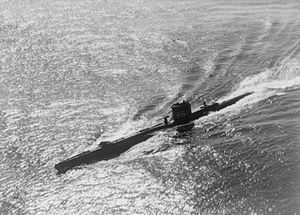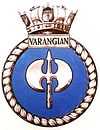HMS Varangian (P61)
 HMS Varangian | |
| Career | |
|---|---|
| Name: | HMS Varangian |
| Builder: | Vickers Armstrong, Tyne |
| Laid down: | 23 December 1941 |
| Launched: | 4 April 1943 |
| Commissioned: | 10 July 1943 |
| Out of service: | A |
| Fate: | Scrapped, 1 June 1949, Gateshead |
| Badge: |
 |
| General characteristics | |
| Displacement: | Surfaced - 540 tons standard, 630 tons full load
Submerged - 740 tons |
| Length: | 60 m (196 ft 10 in) |
| Beam: | 4.90 m (16 ft 1 in) |
| Draught: | 4.62 m (15 ft 2 in) |
| Propulsion: | 2 shaft diesel-electric 2 Paxman Ricardo diesel generators + electric motors |
| Speed: | 11.25 knots (21 km/h) max surfaced
9 knots (17 km/h) max submerged |
| Complement: | 33 |
| Armament: | 4 bow internal, 2 bow external 21-inch (533 mm) torpedo tubes: 8 - 10 torpedoes
1 × 3-inch (76 mm) gun 3 x AA machine guns |
HMS Varangian was a British built U class submarine, a member of the third group of that class to be built. Her commander was Lt. Geoffrey J Gellie RAN. The submarine carried out patrols in the Norwegian Sea, covering Arctic Convoys [1] and seems also to have been used in a training role.[2] She was broken up at Gateshead in 1949. Her ship's bell (inscribed HMS Varangian 1943) is in the possession of the Royal Navy Submarine Museum in Gosport, UK.[3] It was believed that Varangian was the submarine featured in the 1943 film We Dive at Dawn, due to the boat carrying the P61 pennant number. However the submarine in the film was in fact portrayed by other two boats: P614 and P615, with their final digit painted out to disguise the fact that there were two boats being filmed.
References
- Colledge, J. J.; Warlow, Ben (2006) [1969]. Ships of the Royal Navy: The Complete Record of all Fighting Ships of the Royal Navy (Rev. ed.). London: Chatham Publishing. ISBN 978-1-86176-281-8. OCLC 67375475.
- Hutchinson, Robert (2001). Jane's Submarines: War Beneath the Waves from 1776 to the Present Day. London: HarperCollins. ISBN 978-0-00-710558-8. OCLC 53783010.
External links
| ||||||||||||||||||||||||||||||||||||||||||||||||||||||